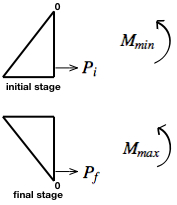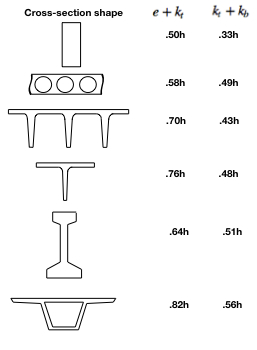The diagram below illustrates the initial and final conditions, with the simplifying assumption that the concrete can take zero tension. At the initial stage, the applied moment is ![]() , and at the final stage, the applied moment is
, and at the final stage, the applied moment is ![]() .
.
(1) ![]()
where, ![]() results from all dead and service live loads
results from all dead and service live loads
Let’s define a new variable: ![]()
(2) ![]()
(3) ![]()
Similarly,
(4) ![]()
where ![]() typically results from the dead load only
typically results from the dead load only
We can define ![]()
(5) ![]()
Note: we are neglecting crushing and making the simplification that ![]()
So,
(6) ![]()
We can see that large ![]() the section can resist large service loads AND will be able to resist a large prestressing force at the transfer stage (ignoring crushing in either case).
the section can resist large service loads AND will be able to resist a large prestressing force at the transfer stage (ignoring crushing in either case).
For a continuous beam, or a continuous slab (positive and negative moments), allowable variation may be as important as the ![]() value. For example, the hollow-core slab above could be as efficient as the box-girder, in such a scenario.
value. For example, the hollow-core slab above could be as efficient as the box-girder, in such a scenario.
(7) ![]()
(8) ![]()
This is what we’ll use for actual design (rather than simply the choosing of section size), as we will see in detail in the following section.
Similarly,
(9) ![]()


